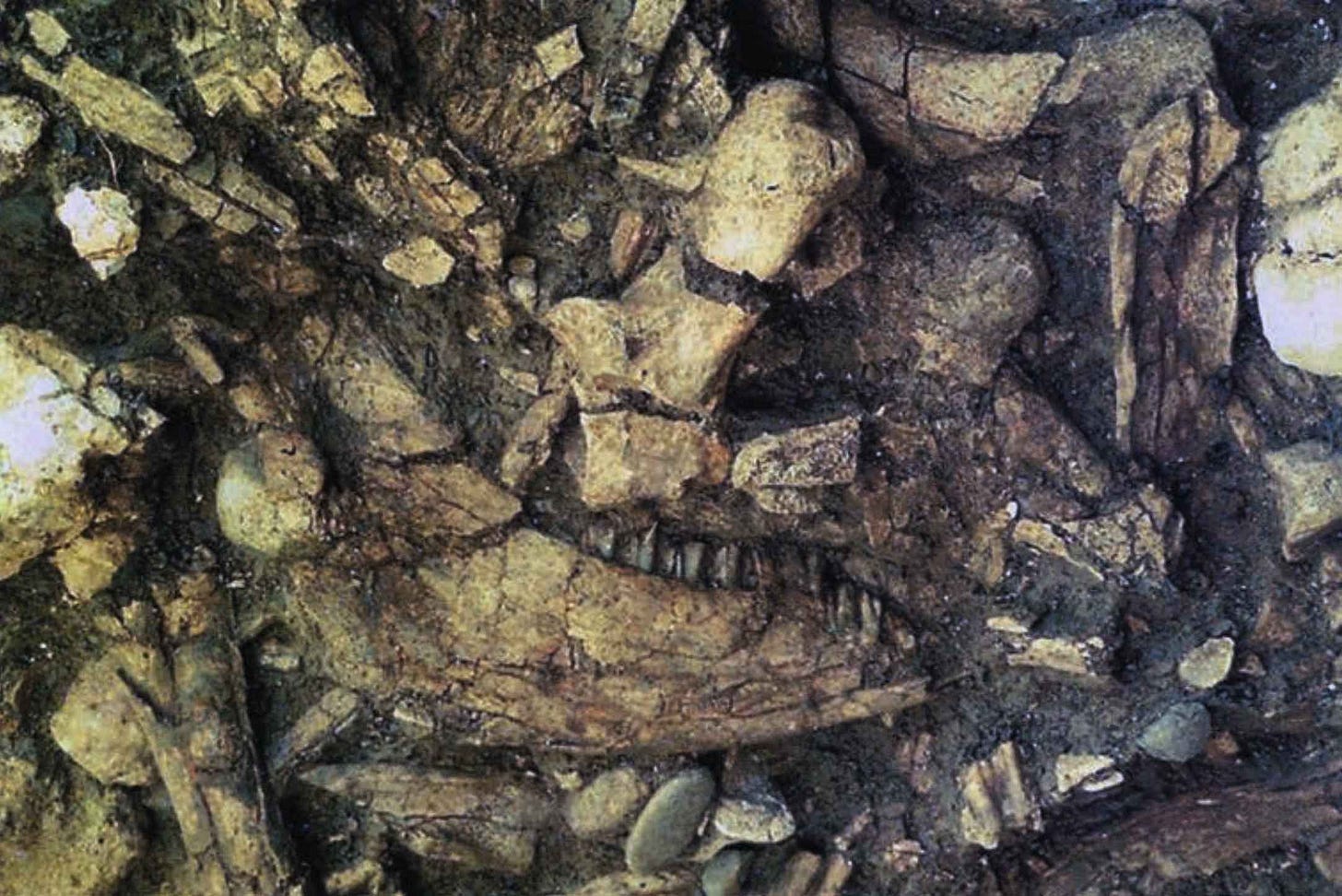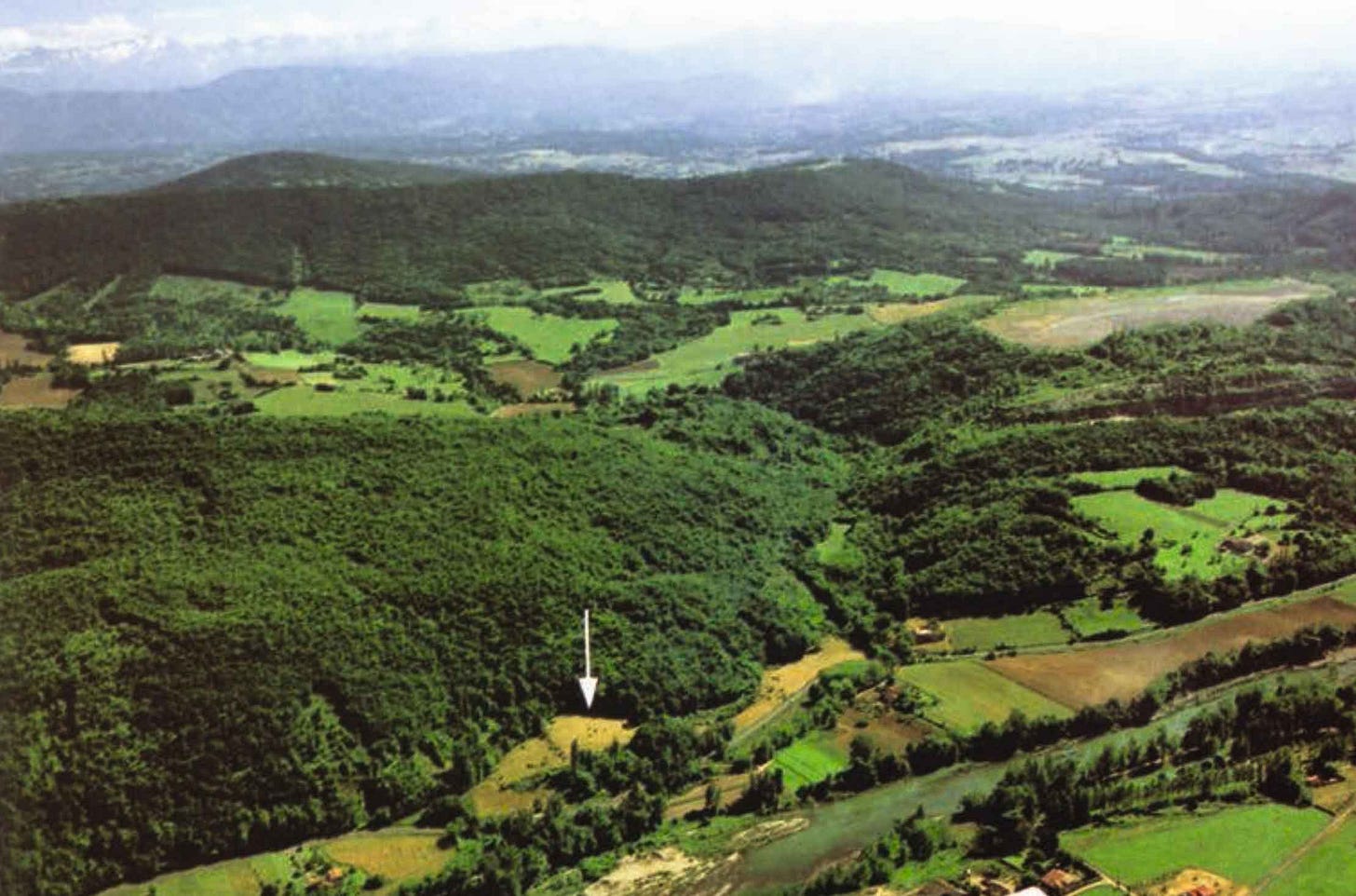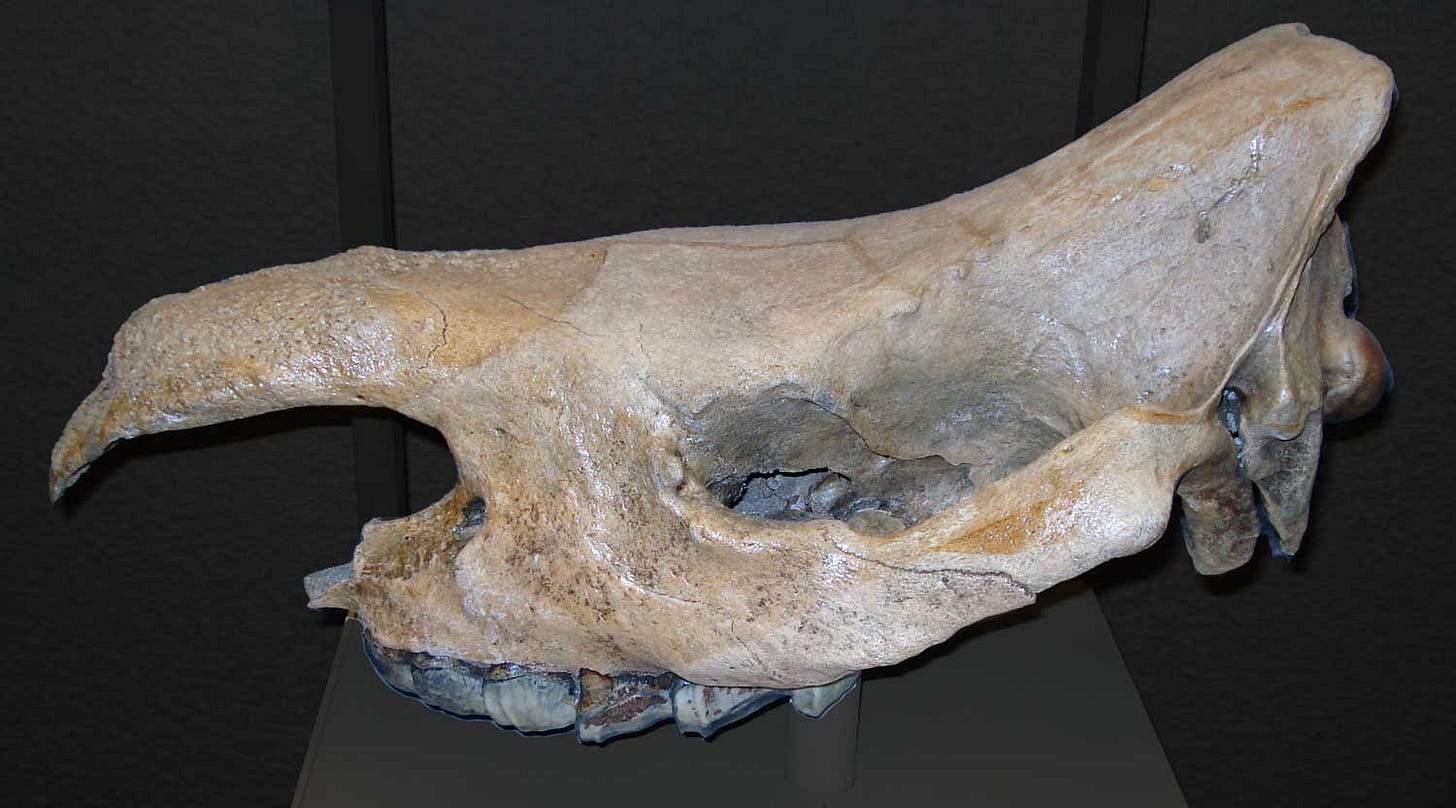Neandertals hunted dangerous prey. How they killed them.
With deep experience in the hunt, Neandertals could anticipate the behavior of many of the most dangerous prey animals.

Neandertals were skilled hunters. Many archaeological sites show their ability to kill large mammals like bison, horse, and red deer. They occasionally killed mammoth or rhinoceros. This could not have been easy, since we have not found evidence that the Neandertals used arrows, atlatls, or other distance-killing weapons invented by more recent people. In the face of these apparent technological limitations, they still got more than half their nutritional input from meat.
Archaeologists have only limited knowledge of the methods that made Neandertals successful hunters. It is hard to reconstruct the circumstances of a kill from a few remaining bones.
Luckily, there are some sites where the bones of prey animals number in the thousands. A recent examination of five of these sites drew a provocative picture of how Neandertals sometimes hunted. Their weaponry may have been limited but their knowledge of animal behavior and landscapes gave them a critical advantage.
Studying large kill sites
Mark White, Paul Pettitt and Danielle Schreve examined data from five “kill sites” in France, Germany, and Poland in a 2016 article, “Shoot first, ask questions later: Interpretative narratives of Neanderthal hunting”. Each of the five sites represents a different species of prey animals: bison, horse, rhinoceros, reindeer, and aurochs. The sites date from varied times between around 120,000 years ago and 50,000 years ago. Together they are a fascinating series of case studies showing how Neandertals hunted.
For example, at La Borde, France, archaeologists in 1971 excavated bones that once belonged to more than 40 aurochs. The context of the site and the faunal remains were described by Jacques Jaubert and coworkers in a 1990 monograph. The site was a natural collapsed cave, called an aven, which made a depression at the base of a long sloping hill.
More than half the aurochs remains came from juveniles, and most of the adult individuals were cows, with few or no bulls present. Aurochs have been extinct since the seventeeth century, so we cannot observe today exactly how they behaved. White, Pettitt, and Schreve relied on history and analogy with other living cattle species to relate what we can know about aurochs social behavior. Like many large herbivores, aurochs would have split for much of the year into herds with mostly cows and calves, some bachelor bulls, and some bull herds. To account for the pattern of the bones from La Borde, Jaubert and collaborators proposed that the Neandertals targeted cow/calf herds. They drove these herds into the aven where the animals could not easily escape.
It's not so easy to usher groups of nervous wild herbivores into the same small hole in the landscape again and again. White and coworkers suggested that the Neandertals had long experience with the behavior of these herds, knowing that a hunter that approached too close toward the front of the group at an angle would cause the animals just off the lead to react, narrowing the herd and driving the leader forward. With this approach, a group of hunters who coordinated their behavior could steer and accelerate the herd across a flat landscape.
“We hypothesize that Neanderthals understood and exploited the flight behaviour of wild cattle…. In short, Neanderthals were the original cowboys.” —Mark White, Paul Pettitt, and Danielle Schreve
At each of the other four sites, White and collaborators emphasized the way that Neandertals used the landscape in their favor. They knew about and used local contrasts in topography, such as valleys that split into narrow side branches or marshes next to steep hillsides. At three of the sites, Neandertals cornered groups of fleeing animals into places with no easy paths of escape—where the hunters then could kill indiscriminately.
Pinned against the cliff
The site of Mauran, France, represents the accumulated remains of more than 130 bison, killed over an unknown span of time. The kill site was flanked by a limestone rock face abutted by marshy land that enabled Neandertal hunters to corner groups of bison where it was hard to escape. At this site, 80% of the bison bones come from juvenile or adult female individuals.

White, Pettitt, and Schreve pointed to earlier work by Katherine Boyle, who showed that the cutmarks and breakage of bones for marrow at Mauran were both less intense than at some sites. She suggested that the Mauran situation was a less-than-complete processing of the bison. Limb bones are underrepresented in the assemblage, and Boyle interpreted this to mean that these parts of the carcass were often carried away from the site. Much of the remaining carcasses were left for scavengers.
After the kill the Neandertals got down to business. Émilie Chaud and collaborators reviewed the record from Mauran and considered what the pattern must imply for the activity after the hunt. They suggested that several days of butchery and other processing may have followed kills. The Neandertals took cobbles of quartzite from the nearby river, making the tools they would use in the butchery and breakdown of carcasses. All stages of tool production were present, without evidence for long preparation.
“When pursuing large numbers of animals, the final stages in Neanderthal hunts were marked by chaos, a killing frenzy that precluded any on-the-spot targeting of individuals.” —Mark White, Paul Pettitt, and Danielle Schreve
The Mauran case illustrates the selectivity of the Neandertals in deciding which of their kills to process and which parts of carcasses to recover and transport off the kill site. Contrary to the stereotype that hunters make use of every part of a carcass, the Neandertals were in fact choosy in eating and taking away the most valuable parts.
Rhinoceros hunters
The site of Taubach, Germany, illustrates a different hunting situation. Here, rhinoceros came to wallow and drink at warm springs. As White and coworkers described the scenario, Neandertals lay in wait under cover of natural brush, where they could watch rhino mothers and calves. Only when a calf wandered far enough from its mother did the hunters strike. This series of events explains why 40 out of a minimum 76 rhinoceros individuals were juveniles between 1 and 1.5 years of age.
The faunal remains from Taubach date to the last interglacial, around 120,000 years ago. Bodil Bratlund documented the rhinoceros bones in a 1999 monograph, showing that cutmarks from muscle and tendon removal occur on every body part—a sign that the Neandertals had control of the kill site for plenty of time before carnivores could ravage the remains.
Planning versus speed
Hominins are not the only predators that cooperate and use landscapes to their advantage. Carnivores like lions or wolves also hunt in ways that make use of natural cover and barriers in the landscape. Several individuals within a hunting group sometimes coordinate their actions, one or two driving the animals to flight and others lying in wait to surprise and bring down the fleeing prey. Wolves often work together to separate one prey animal from a herd, pursuing their quarry to exhaustion.
Neandertals would have been aware of these other predators' strategies. They may even have gotten ideas by watching hunts from a distance. But many of the strategies that worked for lions or wolves could not have worked well for Neandertals, who could not match the speed of the four-legged carnivores.
Where they lacked speed, Neandertals surpassed other hunters in coordinated planning. Several individuals had to commit to a shared strategy and carry it their parts, often out of sight or hearing of each other. They relied upon knowledge of prey animals' social behavior to move them into prepared killing zones, in some cases without driving them to flight until the last minute. Some of the Neandertal hunting strategies would work with only one individual driving a group of animals, but the La Borde situation is an example where moving prey into the right position would have taken at least two or three hunters. In every one of these sites, several hunters would have been waiting quietly in the kill zone, maybe for a long time, before rushing to stab spears at close quarters into frightened, frenzied prey animals.
It is possible that some of these hunters may have constructed blinds to hide them from the approaching animals. This would be consistent with the practices of hunters in many historic small-scale societies. A a simple blind need not have left any archaeological trace. Or natural cover may have been sufficient to conceal the hunters, as White and coworkers speculated for the Taubach site.
The social dimension of hunting
Hunting takes many forms in recent human societies that rely on hunting and gathering wild foods. Some groups engage in hunting that involves coordinated effort by larger groups of people. Men, women and older children often participate in such social hunts, taking varied roles. The meat from a kill of many animals can be far more than a single group of people can eat at a time. Today's people dry meat or practice other methods of long-term meat preservation, so that their efforts can yield benefits over many weeks or longer. Such practices are hard to document archaeologically before the development of large storage pits, but there are some hints that Neandertals may have stored meat, at least at some times and places.
When hunters in a small-scale society make a big kill, word usually spreads far and wide to neighboring groups. In historic societies, these neighboring groups are all connected by kin relations, clan membership, and other affinities that their cultures define. Such relationships can be maintained and strengthened by sharing parts of a kill. It may take hours or even a day or more for word of a large kill to spread, and for people to gather. The sharing of a single large carcass can grow to a multi-day event. The evidence from an ancient kill site like Mauran points to a similar cultural pattern for some Neandertal groups.
Notes: There are extensive references in the article by White, Pettitt, and Schreve that contribute to their reconstruction of each site. Many of these include previous interpretations of the site formation and involvement of Neandertal hunting to the faunal assemblage.
In each of these five cases, there has been full agreement that Neandertals hunted the animals; that each was a kill site. But a read through earlier interpretations shows some diversity in how the evidence relates to Neandertal strategies. Some earlier investigators saw Neandertals as much more selective at the time of the kill, others have often thought in terms of individual animal behavior instead of group behavior. In many cases, White, Pettitt, and Schreve's paper agreed with previous interpretations and in other cases they differed in various ways.
I did a search for photos of each of these sites that I might share with the post and came up mostly blank. Several of these sites were rescue excavations where analysis of the faunal material followed the fieldwork by many years, and the sites no longer exist or were highly disrupted by construction. However, Bachellerie and coworkers' 2011 article has two great photos of Mauran that I was able to share here.
References
Bachellerie, F., Bon, F., Deschamp, M., Eizenberg, L., Henry-Gambier, D., Mourr, V., Normand, C., Pelegrin, J., Primault, J., Scandiuzzi, R., & Thiébaut, C. (2011). Archaeological Signatures of Hunting Activities Applied to Comparisons of Mousterian, Chatelperronian and Aurignacian Industries in the Pyrenees: The Nature of Hunting Tools and Site Functions. Palethnologie. Archéologie et Sciences Humaines, 3, Article 3. https://doi.org/10.4000/palethnologie.7218
Boyle, K. V. (2000). Reconstructing Middle Palaeolithic subsistence strategies in the South of France. International Journal of Osteoarchaeology, 10(5), 336–356. https://doi.org/10.1002/1099-1212(200009/10)10:5<336::AID-OA560>3.0.CO;2-5
Claud, É., Thiébaut, C., Costamagno, S., Deschamps, M., Soulier, M.-C., Brenet, M., Chacón-Navarro, M. G., Colonge, D., Coudenneau, A., Lemorini, C., Mourre, V., & Venditti, F. (2019). The practices used by the Neanderthals in the acquisition and exploitation of plant and animal resources and the function of the sites studied: Summary and discussion. Palethnologie. Archéologie et Sciences Humaines, 10, Article 10. https://doi.org/10.4000/palethnologie.4179
Jaubert, J., Lorblanchet, M., Laville, H., Slott-Moller, R., Turq, A., & Brugat, J.-P. (1990). Les chasseurs d’Aurochs de La Borde: Un site du Paléolithique moyen (Livernon, Lot). Éditions de la Maison des sciences de l’homme.
Marín, J., Saladié, P., Rodríguez-Hidalgo, A., & Carbonell, E. (2017). Neanderthal hunting strategies inferred from mortality profiles within the Abric Romaní sequence. PLoS ONE, 12(11), e0186970. https://doi.org/10.1371/journal.pone.0186970
Bratlund, B. (1999). Taubach revisited. Jahrbuch des Römisch-Germanischen Zentralmuseums Mainz, 46(1), 61-174.
White, M., Pettitt, P., & Schreve, D. (2016). Shoot first, ask questions later: Interpretative narratives of Neanderthal hunting. Quaternary Science Reviews, 140, 1–20. https://doi.org/10.1016/j.quascirev.2016.03.004


